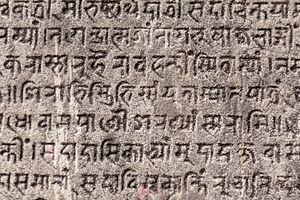Recently, the Indian news site Scroll.in had an interesting debate on the relative merits of writing the Hindi language in the Roman alphabet instead of the native Devanagari script, triggered by a much derided photograph of Indian politician Rahul Gandhi carrying around notes in Roman Hindi.
One author at Scroll.in, Keshava Guha, argued for Hindi to keep the Devanagari script, a position that I agree with for both reasons of cultural continuity and linguistic utility. Simply put, there is no reason for Hindi-speakers not to use the Devanagari script (this applies to the scripts of other languages as well), even on computers, with the widespread appearance of transliteration software like Google Input, which allows one to type in the Roman alphabet and get that automatically converted to another script (Google Input is now embedded on many websites so one does not even need to switch between tabs).
From a historical perspective, using a language’s native script adds depth to the language—not only does it record speech, but it provides clues about history, etymology, and meaning. When lost, this depth cannot easily be translated into a new script, with the Roman script being the script of choice for most. Not much Persian literature survived the transition of the language from using the Pahlavi to Arabic scripts in the 7th century, but in the 1,300 years since then, much literature has been built up in the Perso-Arabic script. It would be foolish to change the Persian script to the Roman or Pahlavi scripts at this point.
However, the most important reason Hindi speakers and other linguistic groups should stick with their traditional scripts is that there is already a standardized spelling and written literature in these scripts; and transliteration into a new script would be a long and often arbitrary process especially since the Roman alphabet has only 26 letters. For many languages, switching to the Roman alphabet would often require extra symbols which requires special computing tools, basically defeating the point of switching from a technological perspective. Most Indian languages have more than 40 sounds and individuals typing in the Roman alphabet transliterate these into the Roman alphabet very arbitrarily, making standardization difficult to enforce. For example, the long a sound (आ) is often written out both “a” or “aa.” A sound represented by the letter ष, somewhere between the s and sh sounds is ambiguously transcribed in English, leading to confusion on the pronunciation of the common word Sri. Finally, the a letter like t is often used to represent two separate sounds that are not distinguished in European languages, त and ट. The only way to get around these problems is to continue to write Hindi with Devanagari, with some exceptions made for transcribing short words and phrases for foreigners.
On the other hand, Shoaib Daniyal made the argument that Hindi should switch to the Roman script. At the core of his argument is the contention that since the dawn of the internet and the use of English as the prestige language in India, more people know the Roman alphabet anyhow or are comfortable using it to write Hindi (or Telugu or Bengali and so on). This is not true. It is true that some Indians, especially those of educated in elite English-speaking schools are basically functionally illiterate in Hindi in the Devanagari script as most of what they read and write is in English. This, however, is their problem and not a problem with the language’s script. The elite, in fact, has rather chosen not to learn how to write and read Devanagari well.
Underlying this statement is the argument that Devanagari Hindi is backwards and unmodern and that by “clinging to all that is old” like Devanagari, Hindi cannot be revitalized like Turkish.(In an unnecessary move, Turkish switched from the Arabic script to the Roman script in 1928 under Kemal Ataturk’s modernization program.) Throughout the 20th century, many Asian languages have undergone changes in their writing systems, often driven by this erroneous belief. A language can be modern or not based on the purposes for which it is used, script notwithstanding.
Beyond occasional spelling reforms, the idea that a language’s script needs to be changed will only lead to a needless cultural mutilation without any corresponding gain toward economic and social development.
There is no particular correlation between the difficulty of a given script and the literacy rate of its users. Japan, for example, has a near universal literacy rate despite using its traditional script (some slight reforms were made in the 19th and 20th centuries) while Afghanistan, which uses the much simpler Perso-Arabic script, barely maintains 50 percent literacy. The difference comes down to the ability of the state and schools to impart literacy to children through an effective education system. China has managed to attain a high literacy rate despite the Chinese language’s use of thousands of characters, a result no different than that in Vietnam, where Vietnamese was formerly written in a variation of the Chinese script but has now switched to a rather strange variation of the Roman alphabet derived from Portuguese orthography. Even China did not need to simplify its script—even places like Taiwan and Hong Kong that continue to use traditional characters have had no problems with education and literacy.
The key to modernity is effective mass education which can be imparted in any script as long as the educational system works. Beyond that, the creation of modern scientific and literary content in Asian languages is essential. There is no need to assault millennia-old writing traditions to bring a country and its language into modernity.

































